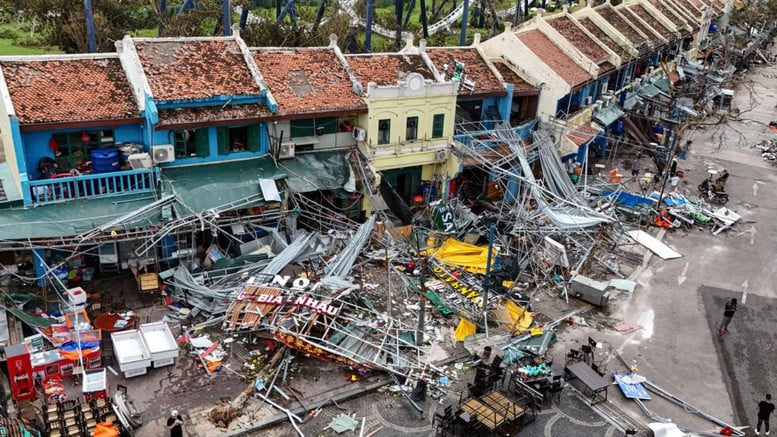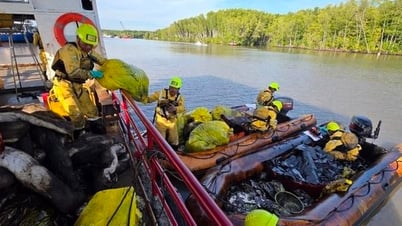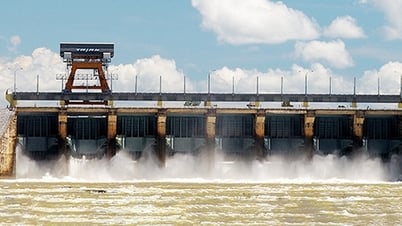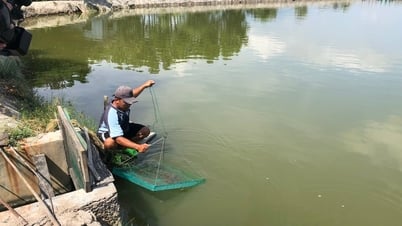
Localities need to direct the Department of Agriculture and Environment to coordinate with relevant agencies and units to carefully inspect and evaluate the current status of the dike and irrigation systems before the rainy and stormy season.
The Ministry of Agriculture and Environment has just issued a directive on strengthening construction safety assurance. dykes and irrigation in the rainy and flood season of 2025. Accordingly The Minister of Agriculture and Environment requested the Chairmen of the People's Committees of provinces and centrally-run cities to focus on directing the implementation of the following key tasks:
Regarding proactive and prepared response to natural disasters, it is necessary to organize a summary and assessment of the work of ensuring the safety of dike and irrigation works in the area (especially the work of responding to storm Yagi and floods after the storm); consolidate and specifically assign responsibilities to specialized management agencies, local authorities at all levels and forces in the area according to the motto "clear people, clear work".
Localities need to direct the Department of Agriculture and Environment to coordinate with relevant agencies and units to inspect and carefully assess the current status of the dike and irrigation system to detect damage and adverse factors that threaten the safety of the works; proactively develop, approve and deploy plans to ensure the safety of the works (especially key locations and areas, construction incidents that occurred during storms and floods in 2024 but have not been repaired or remedied) according to the "4 on-site" motto.
Along with that, the Departments of Agriculture and Environment need to preside over and coordinate with relevant agencies and units to guide and inspect the implementation of work to ensure the safety of dike and irrigation works in the area.
Localities need to organize drills on dike protection plans and emergency response plans for reservoirs; check the preparation of materials, forces, means, techniques, command and communications to promptly fill in any shortcomings and problems.
Review and evaluate the operating procedures of culverts under the dikes, especially those under the dikes of pumping stations, to make appropriate adjustments and supplements to ensure flood safety. For culverts without operating procedures, the Department of Agriculture and Environment will urgently direct the development and approval before the rainy and flood season for immediate implementation in 2025.
Review and evaluate the tasks and operating procedures of reservoirs; report to competent authorities for appropriate adjustments and supplements to ensure safe operation of works, especially reservoirs that have a major impact on the flow and people's lives in downstream areas.
Organize trial operations of pumping stations, culverts under the dike, dyke gates, sluice gates, and equipment serving flood discharge of reservoirs, promptly overcome existing problems to ensure safe operation (especially the existing problems and shortcomings exposed during the response to floods after storm No. 3 in 2024).
Organize the clearing of roofs, dike toes, dams and within the protection area of the works to serve the patrolling, detection and timely handling of incidents during the rainy and flood seasons; clear and remove obstacles and obstructions encroaching on riverbanks and riverbeds, etc.
Review and identify dangerous areas, especially steep slopes at high risk of landslides and downstream areas at risk of flooding, to proactively organize the evacuation of people and property from dangerous areas. For areas where immediate evacuation is not possible, localities must have proactive evacuation plans in case of natural disasters to ensure safety.
For construction incidents that occurred in previous rainy and flood seasons (especially incidents that occurred during storm No. 3 in 2024 and the floods caused by the storm), special attention and resource concentration are needed to complete the handling; at the same time, a key protection plan must be developed for the rainy and flood season of 2025;
Review and make a list of damaged and degraded works that are at risk of being unsafe, and reservoirs that must have a maintenance process established; proactively arrange funding from the local budget and other legal sources to prioritize the handling of key dykes and vulnerable reservoirs;
Direct the Investor and relevant agencies to strengthen inspection, supervision, timely detection and resolution of difficulties and problems to speed up the construction progress of dike and irrigation works (especially works to repair and overcome incidents and damage caused by floods; works with the task of blocking streams, constructing flood crossings, preventing floods, inundation, saline intrusion, drought, landslides in 2025 and projects under the Medium-term Public Investment Plan for the period 2021-2025).
Ensuring construction safety during the rainy and flood season
For the dike system, it is necessary to closely monitor the developments of rain, floods, and storms; prepare forces, materials, and means to proactively deploy dike protection plans, protect key dike points according to the "4 on-site" motto when situations arise. Organize forces and strictly implement patrolling and guarding to protect dikes during the flood season according to the provisions of Circular No. 01/2009/TT-BNN dated January 6, 2009 of the Ministry of Agriculture and Rural Development (now the Ministry of Agriculture and Environment) to promptly detect and handle dike incidents from the first hour;
Particularly for culverts under the dike, it is necessary to focus on and pay attention to implementing the following contents:
For culverts under the dike that have had incidents in previous years, newly built culverts that have not been operated in high flood conditions or culverts under construction, a specific protection plan must be developed to proactively handle incidents when they occur.
Organize inspection and careful assessment of the quality of culverts under the dike, detect weak culverts, damaged culverts for repair, temporary or permanent closure if not safe; for important culverts, there must be a protection plan approved by competent authorities, in which specific tasks are assigned to organizations and individuals to prepare conditions and organize implementation...
The use of culverts under the dike during flood season must strictly comply with operating procedures and ensure flood safety.
For culverts managed by Companies, Irrigation Works Management Centers or Irrigation Sub-Departments, the management unit must have regulations, assign specific responsibilities, and closely coordinate with localities in implementing protection plans and handling incidents.
For irrigation systems, it is necessary to arrange a force with sufficient professional capacity to manage and operate the works according to regulations; the operation of reservoirs must strictly comply with approved operating procedures...
Strictly implement specialized hydrometeorological monitoring regime and calculate water flow to the lake, estimate the possibility of increasing water level in the lake to proactively operate the reservoir to prevent floods safely.
Regarding management, it is necessary to direct the strengthening of inspection of the dike and irrigation system to promptly detect, resolutely prevent and strictly handle violations according to the provisions of law on dikes and irrigation.
Directing the resolute handling of acts of encroachment on the dike surface, roof, and dike protection corridor that affect the safety of the dike and the ability to drain floods, encroachment, and illegal use of land within the protection area of dike and irrigation works. Ensuring smooth communication and synthesis, timely reporting of incidents to the Ministry of Agriculture and Environment when dike and irrigation works occur ;
Do Huong
Source: https://baochinhphu.vn/tang-cuong-dam-bao-an-toan-cong-trinh-de-dieu-thuy-loi-trong-mua-mua-lu-102250509103529036.htm



![[Photo] Prime Minister Pham Minh Chinh works with the Standing Committee of Thai Binh Provincial Party Committee](https://vphoto.vietnam.vn/thumb/1200x675/vietnam/resource/IMAGE/2025/5/12/f514ab990c544e05a446f77bba59c7d1)

![[Photo] Prime Minister Pham Minh Chinh receives Swedish Minister of International Development Cooperation and Foreign Trade](https://vphoto.vietnam.vn/thumb/1200x675/vietnam/resource/IMAGE/2025/5/12/ae50d0bb57584fd1bbe1cd77d9ad6d97)
![[Photo] Prime Minister Pham Minh Chinh starts construction of vital highway through Thai Binh and Nam Dinh](https://vphoto.vietnam.vn/thumb/1200x675/vietnam/resource/IMAGE/2025/5/12/52d98584ccea4c8dbf7c7f7484433af5)




















































































Comment (0)